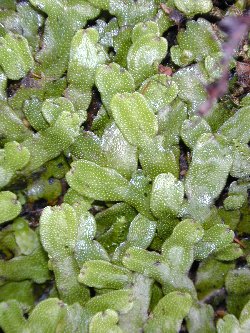| |
|
Key to Aquatic Plants of the Hawaiian Islands
|
|
|
|
|
[VASCULAR or NON-VASCULAR PLANT ?]
|
|
24a
|
(2) |
Plant has leaves, stems, and roots AND these structures contain internal conductive tissues (elongated cells that move liquids within the plant) { usually visible in leaves as "veins." Plant may have flowers. Vascular plants
|
[70 ] ]
|
|
24b
|
|
Plant body (thallus) not clearly differentiated into leaves, stems, and roots; may have blades or even thickened, stem-like parts which are one or several cells thick, but lack internal tubes to conduct liquids. Plants with reproductive structures not flower-like
|
[25] |
|
~~~~ ~~~~~~~~~~~~~~~~~~~~~~~~~
|
|
25a
|
(24) |
Plant small, either a simple prostrate blade, prostrate branching blade, OR lax to erect stem covered with blades arranged radially (coming out in many directions). Rhizoidal growths attach plant to rock or soil.
|
[26]
|
|
|
25b
|
|
Plant even more simple: either single cells, or cells arranged in a chain (= filamentous), OR thallus (plant body) of cells (single or in chains) held together by gelatinous material, OR if thallus a blade then only one or two cells thick
|
[28] |
<
|
~~~~ ~~~~~~~~~~~~~~~~~~~~~~~~~
|
|

|

|
|
Figure P1A. Indet. liverwort growing along Pahe‘ehe‘e Stream at 480 m, Hamakua Coast, Hawai`i.
|
Figure P1B. Hornwort (?Anthoceros sp.) growing on the bank of Manoa Stream, O‘ahu. Note projecting sporophytes.
|
|
|
26a
| (25) |
Plant a simple prostrate blade or a prostrate branching blade (Figs. P1A & P1B1). Rhizoidal (root-like) growths attach blade to wet rock or soil. Not normally submerged, but growing on wet surfaces in somewhat shaded situations, particularly near waterfalls and under wet overhangs. Thallose liverworts and hornworts [RIP]
~ HEPATICAE & ANTHOCEROTAE
|
[70 ] ]
|
|
26b
|
|
Plant thallus of more complex shape (Fig. P1C): having a linear or long axis with side branchlets or blades arranged in whorls
|
[27]
|
|
~~~~ ~~~~~~~~~~~~~~~~~~~~~~~~~
|
|
27a
|
(26)
|
Whorls off main axis narrow and, seen under magnification, composed of elongate single cells linked end to end (filamentous). Growing submerged (algae: Chlorophyta, Family Characeae).
|
[28]
|
|
27b
|
|

|
Plant more complex: whorls of small blades, usually acute (tips pointed). Sometimes submerged in streams, but more commonly seen as dense, low growing mats in moist situations. Mosses
~ MUSCI
|
[101]
|
|